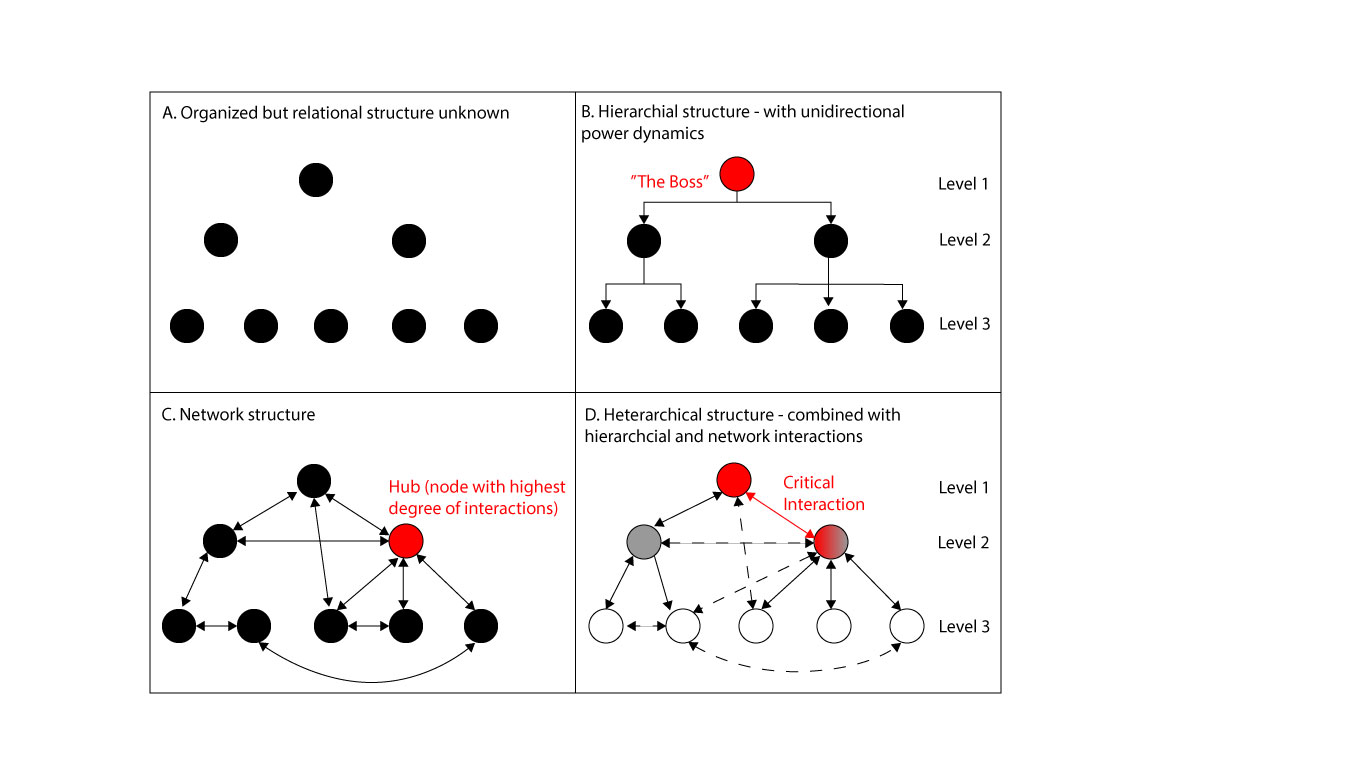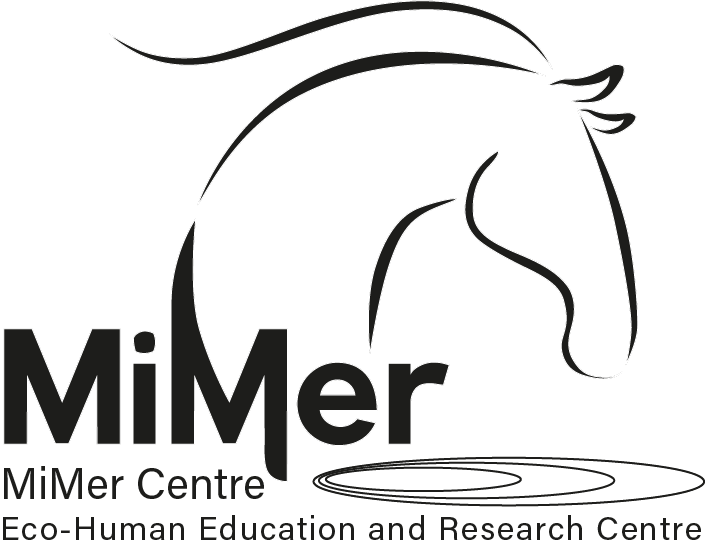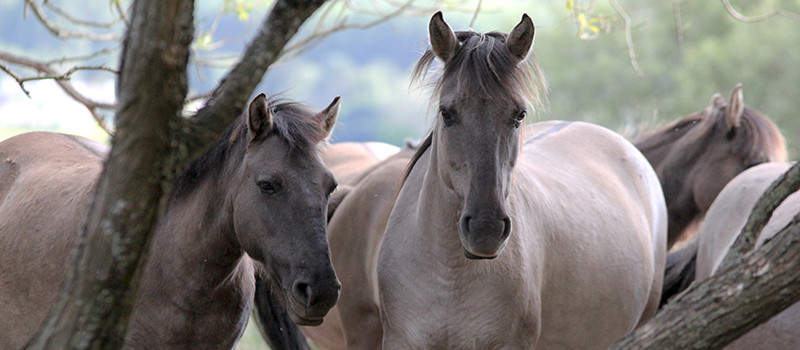HORSES ORGANIZE THEMSELVES IN HETERARACHIES – NOT HIERARCHIES…
For a very long time – I have debated that the one dimensional and linear traditional hierarchies that people tend to see in horse bands (or horse herds) are not there. I have written about it several times before, in book chapters, blogposts and in posts on FB. And now I will come at it from a slightly different perspective.
Maybe we see the hierarchies because we do not know what else to see? It is very hard for most people to see something that they do not know exist. Observing/looking/seeing without any preconceived notions is not possible. But if you do not even know what biases you are likely to have, or even does not know about biases at all, then you will think you see what you see. You will believe your own conclusions, based on your existing knowledge and experiences.
This is why the argument – “I know what I see” – is not valid. As you can only see what you already know about. To see something else, you need to open up for other possibilities.
To help with that I am asking you to think about – can there be other ways horses organize themselves socially than in hierarchies, than having a lead mare or a lead stallion? Can horses interact with each other in other ways than either being dominant or submissive? Can they have other personality trait that goes beyond the dichotomy of dominant/submissive?
DIFFERENT MODESL OF SOCIAL ORGANIZATION
I want to introduce the idea to you that horses (or any other group of beings) can organize themselves in myriad of ways, and that how they organize themselves is not static. Different situations, different environments, different individuals, different circumstances – make groups organize – and re-organize themselves to adapt. Their current social organization, in the moment, serves a purpose, but is also the result of what is at hands (individuals, available recourses etc.).
I have written before on how group size impacts social organization in horses: https://www.mimercentre.org/index.php/blog/cohesion-synchrony-swarm-intelligence-and-hierarachy-group-structure-and-dynamics-in-horse-bands
Since how horses organize themselves functionally – how they do that will of course also differ depending on predator pressure and the kind of predator they encounter. Horses do not behave in the same ways (or interact with each other in the same ways) – when they graze together as when they flee together. But social structure will also vary because of the varying status with each horse present in the group, like e.g. if the group includes lactating mares and foals, elderly or injured horses.
Think about it – are you always the same, behave and interact in the same ways? Take the same roles in all situations? Aren’t you different in a sea of people waiting to board a train at a crowded train station platform to how you are at home having dinner with your family (or on your own)? Why do we think horses are the same all the time? Always behave in the same ways? Take the same place in a structure? Relate the same to everyone around them, according to some innate and dominant trait? No, an individual relates differently to different individuals around them. But many other factors than who is around them also play a role. Like their individual state, status, mode, needs, prior experiences and so on. The variables that make up an individual is present exponentially in the number of variables between individuals in a group.
Behavior is contextual. As roles are. As content and structure of communication. When we look at behavior and social dynamics and structures in a group, of e.g., horses, we come up with very simplistic models. Models that often are static and linear. And when we test them, we test for one hypothesis at a time, thinking (hoping?) we can isolate parts of a bigger whole and only look at e.g., the question; Are there lead mares in a group of horses? And then answer that question with a yes or no.
I prefer a research approach that asks – what does the social interaction dynamics in a group of horses look like? And then I still need to account for all the other factors that will impact that exploration (environment with all its variables is a huge one, but also of course – which unique individuals are part of this group?)
HETERARCHIES VS HIEARCHIES
A hierarchy is a very linear model. It has a pyramidic shape. One leader, a boss – then the next level of middle leaders (middle-bosses) and then another layer (there can be many layers), at the bottom you find the individuals who has no one below them. In what situations would it be good for a horse band (or herd) to have this organization? What function would it fill? What problem would it solve? What purpose would it serve?
These are the questions we need to ask ourselves, not what it looks like to us.
The picture shows a couple of different models of social dynamics and interactions (not specific to horses). There are plenty more models and each of them come with variables themselves. I just wanted to show you that if we only have one of these models in our heads when we go out and look at horses in a group, we will see what we know about (this does not pertain only of course to looking at horse groups, this is true for whatever you look at). If you do not mange to turn it around and more openly observe with curiosity of what is in front of you, where you actively do not try to fit what you see into what you already know, you will in your “observations” find what you look for. And you won’t be able to see what is actually there.

I suggest we leave the concept of hierarchies as the main structure to debate when it comes to social organizations in horse groups. I suggest you look at others, and I will for now only direct your attention to heterarchies.
Definition: “heterarchy, form of management or rule in which any unit can govern or be governed by others, depending on circumstances, and, hence, no one unit dominates the rest. Authority within a heterarchy is distributed. A heterarchy possesses a flexible structure made up of interdependent units, and the relationships between those units are characterized by multiple intricate linkages that create circular paths rather than hierarchical ones.” (Britannica, https://www.britannica.com/topic/heterarchy)
I have highlighted the word “distributed” in the definition. Even in a hierarchy power and control is distributed, even if that is not sanctioned from the top. A “boss” can simply not make all decisions. The more decisions a boss wants to make, the more vulnerable they will make themselves.
In my mind, I keep on coming back to the question of why we humans are so in love with structures with a “strong leader”? What is it in that concept or construct that is so appealing to most of us? That we even need to see it in all structures around us? What is it that is so threatening with distributed power, control and decision making? And why are we so in love with this ordered way of organization? Where the pattern looks “nice”?
And why do we need to see it in horse groups? What is the purpose for us, to keep these views? This leads me to point out that behind every observation, there is an observer.
THE OBSERVER
You can ask yourself as being the observer; Why do I want to see hierarchies in horse groups? What is it with this way of social organization that appeals to me?
There are, de facto, no observations without observers. You who observe are filtering your observations through who and how you are, what you believe, what you know, what you have seen before – as well as what you want to see, find, and confirm.
So, who are you? How do you operate in the world? What do you already know? What values and believes do you carry? What do you want to find and prove?
I have written about our lenses before as well. The more we can become aware of them, the more interesting will it be to observe (oneself as the ones you are observing). Because then you can start to ask yourself, what is it of me that I see in what I look at?
And I assure you we all do that. See ourselves, our past, our dreams – different parts of us – in what we look at. No one is objective. No one can see anything impartially or unbiased. We are always present in everything we do, also when we observe, when we do research, when we try to understand things. We all then bring in our unique perspectives on things. The more aware of this you are, the less you will look for what is wrong or right. But open up for different ways of seeing, also when you see (observe) horses.
DOMINANCE/SUBMISSIVENESS VS HIERARCHIES
I have come across the idea that just because some sees hierarchies in horse groups, does not mean they support the idea of dominance and submissiveness. I can’t see how one could exist without the other.
How do you separate dominance from hierarchies? Can you have a hierarchical relationship or group structure without dominance? Can you have dominance without hierarchical relationships or group structures?
I don’t think so. The idea of dominance and submissiveness as innate traits are what holds the idea of hierarchies in place. If there would be no dominance or submissiveness – then there is no hierarchy. Then we could call the structure “family” instead (e.g.). There is nothing that says to make a group function there needs to be those with more power and control and those with less. If we support that idea – we support inequality. Which we have supported, still support within our own species. Many do apply structures of hierarchy in their families, organizations, businesses, in schools etc.
I would argue that this is an historical left-over we do not need. If we want to take care of what each one of us can bring, hierarchies are not the best structure to that within. And I do not think other species can afford the losses that occur when a group organize themselves hierarchically. In a hierarchy, with dominant leaders and submissive followers, much competence, drive, support, engagement etc., is lost.
Then again – to complicate it further. I am not saying leading and following always goes hand in hand with being a leader or a follower or being dominant or submissive 😉 I often stay away from using these words, “leader” and “follower” – as how they are interpreted by different people vary a lot. But I am not dismissing that leading and following occurs – and is necessary. But I think belongs to the realm of knowledge, competence, age etc – not innate traits, and not a way that social groups somehow spontaneous arrange themselves into hierarchies depending on innate traits that rank member of a group according to some innate social status beings are born with.
As a parallel, just by looking at another place where we discuss organizational structure, the business world, we know that organizations and businesses need different kinds of leadership (not necessarily different leaders – depending on flexibility) in different phases of an organization’s life. Simply because different competencies and strengths are needed in different situations. What you need in a small startup is not the same as what you need in a 150-year-old organization with thousands of employees. That goes for structures too.
I think we have to rethink the whole concept of how horses organize themselves socially. I repeat, it is not about what we see, think we see or want to see, it is about what role their social structures play for the horse individuals involved in each group we look at. We need to look at it from the perspective of the horse. Not us.
And – to end for now. One thing a group that all work together to stay alive do not need, is internal fighting, or to waste energy unnecessarily. Such things you cannot afford to engage in or spend when survival is what you want, not even when you reach a level of thriving. Disruption, competition and chaos is at all costs to be avoided. Collaboration is what is supported. And collaboration can not rest on inequality. Then there will be unnecessary conflicts… leading to unnecessary losses. And the potential collapse of a group (and its structure).
Which is what we see in the human species. We are the ones with hierarchies. And then we have projected these hierarchies onto almost every other species we have studied, in some way, shape or form. But just because we organize ourselves in hierarchies, does not mean other beings do. And hopefully we have come to question the efficacy or even the humanity ourselves of doing so. But we have not yet found a great alternative, though through history we have tried different ones. But then again, we are also a species that exists all over the globe in and live together like no other species do.
If you are curious at what I have written before on these topics, you find some of it in my articles on Academia: https://lu.academia.edu/KatarinaLundgren
Horse band = 2-20 horses living together in a family or extended family group. Within that band, smaller units exist, often with mares and their offspring.
Horse Herd = 2 or several horse bands coming together to form a bigger whole, often as a defense against e.g., pumas, or humans.
Text and picture are copyright protected © Katarina Lundgren 2022
When you subscribe to the blog, we will send you an e-mail when there are new updates on the site so you wouldn't miss them.


Comments 1
I have been watching my donkeys. Two jennies, one a larger standard and the other a honking big mammoth. They seem to take turns (every few days) being dominant and submissive. It is feeding time related. Lots of gesturing with one withdrawing from the feed in question. I make sure there are several areas to feed. Is this an example of a fluid type of heterarachy? They are quite expressive. Who knew that their faces had so many things to say. Body gestures, feet and tails. I love watching. When I move in to the area they subside and are careful not to let me get caught up in the drama.